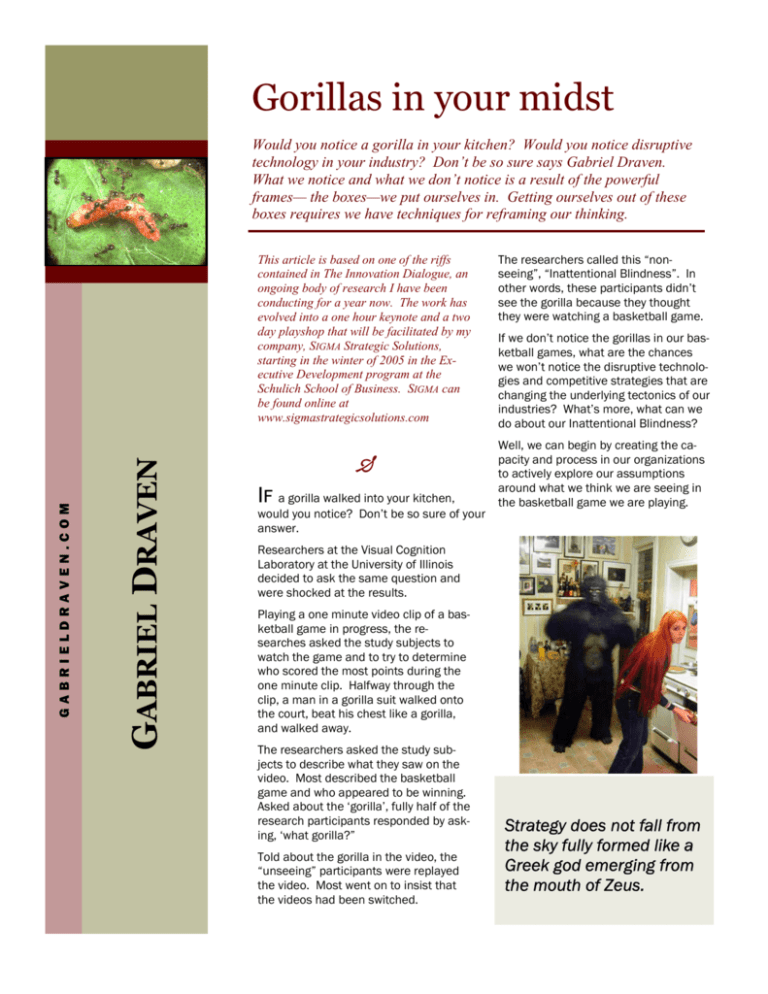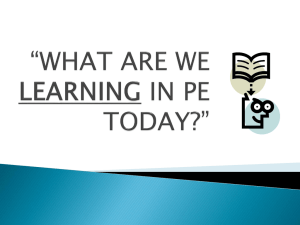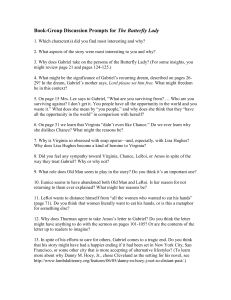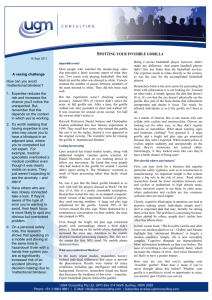gorillas in your midst.pub
advertisement

Gorillas in your midst Would you notice a gorilla in your kitchen? Would you notice disruptive technology in your industry? Don’t be so sure says Gabriel Draven. What we notice and what we don’t notice is a result of the powerful frames— the boxes—we put ourselves in. Getting ourselves out of these boxes requires we have techniques for reframing our thinking. GABRIEL DRAVEN GABRIELDRAVEN.COM This article is based on one of the riffs contained in The Innovation Dialogue, an ongoing body of research I have been conducting for a year now. The work has evolved into a one hour keynote and a two day playshop that will be facilitated by my company, SIGMA Strategic Solutions, starting in the winter of 2005 in the Executive Development program at the Schulich School of Business. SIGMA can be found online at www.sigmastrategicsolutions.com ¶ IF a gorilla walked into your kitchen, would you notice? Don’t be so sure of your answer. The researchers called this “nonseeing”, “Inattentional Blindness”. In other words, these participants didn’t see the gorilla because they thought they were watching a basketball game. If we don’t notice the gorillas in our basketball games, what are the chances we won’t notice the disruptive technologies and competitive strategies that are changing the underlying tectonics of our industries? What’s more, what can we do about our Inattentional Blindness? Well, we can begin by creating the capacity and process in our organizations to actively explore our assumptions around what we think we are seeing in the basketball game we are playing. Researchers at the Visual Cognition Laboratory at the University of Illinois decided to ask the same question and were shocked at the results. Playing a one minute video clip of a basketball game in progress, the researches asked the study subjects to watch the game and to try to determine who scored the most points during the one minute clip. Halfway through the clip, a man in a gorilla suit walked onto the court, beat his chest like a gorilla, and walked away. The researchers asked the study subjects to describe what they saw on the video. Most described the basketball game and who appeared to be winning. Asked about the ‘gorilla’, fully half of the research participants responded by asking, ‘what gorilla?” Told about the gorilla in the video, the “unseeing” participants were replayed the video. Most went on to insist that the videos had been switched. Strategy does not fall from the sky fully formed like a Greek god emerging from the mouth of Zeus. Continued ……. Gorillas in your midst Assumptions about your competition: Classic strategic analysis often begins with defining the competitive framework. This enables us to put boundaries around our analysis. So, what are your assumptions around who you compete with? Does Timex compete with Rolex? After all, both are watch companies. Does Kia compete with Porsche? After all, both make cars. This question is a classic one in most business schools. Our assumptions around the competitive framework of our industries are often powerful perceptual boxes we put ourselves in. I once did a nine-month strategy study for a major foodbank in Canada. Asked who they competed with, the management team replied, “we don’t compete with anyone”. Yet, further exploration revealed they competed with other NGO’s for donations and for the attention of legislators and bureaucrats. What’s more, the powerful new warehousing technology that was reducing wastage among the food retailers who traditionally donated pallets of ‘damaged’ food to the foodbank also constituted an indirect and non-traditional ‘competitive’ threat. Including these factors in their strategic framework deepened the competitive agility of the organization. Assumptions about your customers We often become obsessed with our customers because, after all, that’s what all the best selling books and consultants tell us to do. But is it possible we pay too much attention to our customers? Is it possible we should ignore our customers just for a while? Wal-Mart is the most dominant retailer in the world and one of the most powerful companies in the Page 2 world. Yet, only 14% of Americans routinely shop at Wal-Mart. Question: what are the other 86% doing? Classic strategic analysis tells us to focus on the 14%, something Wal-Mart does better than most companies can ever hope to do. Meanwhile, huge opportunities lie in the other 86%. rything it could to stop the introduction of VCRs, Beta and VHS. The department stores knew their customers well. They focused so much on them that they failed to notice the profound demographic shifts taking place in the 60’s and 70’s that shifted populations from the cities to the suburbs. As populations shifted, the department stores continued to focus on their core customers so acutely that after a while, all that was left were the proverbial little old ladies having lunch in Arcadian Court. Insight: little old ladies don’t buy the $100 perfume and the latest fashions that drive retail profits. Assumptions about strategic advantage: Assumptions about how you make money: The music industry knew how it made money. It made money by selling over-priced, over-hyped CDs. An 18 year old changed that forever. Insight: suing your best customers isn’t one of the better competitive responses you can formulate. There are others that are much better. Some artists have figured out that the fundamentals of the music business have shifted forever. Ani DiFranco sells her own music from her own web site and garners a per unit profit margin double the industry average. Around the world, thousands of indi artists are making the shift. The same will happen to the movie industry and the publishing industry. Digital download and self-publishing will eventually do to the business models of these industries what Napster did to the music industry. If you doubt the inability of the movie industry to adapt to this disruptive technology, consider that Hollywood did eve- Question: will your assumptions of how your industry makes money prevent you from evolving when disruptive technology enters your competitive realm? Question: If you were a Swiss watchmaker, what would you do with the quartz movement you invented? For hundreds of years, the Swiss knew watches better than anyone on the planet. The Swiss understood that watches were jewelry, watches were a symbol of refinement, watches were about more than telling time. The Swiss knew that the finest watches were achievements of mechanical craftsmanship. Then the Swiss invented the quartz movement. The quartz movement enabled watches to be made cheaply. But of course, the Swiss knew no one wanted cheap, junk watches. The quartz movement fell outside of the perception the Swiss had of their industry. Subsequently, they didn’t value the invention and so did nothing to protect their ownership of it. In fact, they shared the design with a funny little Japanese company called Seiko that wanted to make funny little junk toy watches. They didn’t license it. They didn’t patent it. They gave it to them. Within ten years, the Japanese owned the global watch market and the Swiss laid off 50,000 watchmakers in their industry. Question: what assumptions do you have about how competitive advantage is created in your industry and what gorillas do these assumptions prevent you from seeing? All companies love talking about beGABRIEL DRAVEN ing innovative, being strategic, being creative. But you don’t ‘BE’ these things. Instead, you build processes that enable you to think innovatively, think creatively and think strategically. The process of innovation is really the process of questioning. And herein lies the problem. In our business culture, we don’t reward leaders who lead a process of questioning; we don’t reward being introspective. We consider introspection to be a sign of weakness and indecision; we demand that our leaders know the answers. But innovation, like strategy, is emergent, it is non-linear —it doesn’t emerge fully formed like some Greek god out of the mouth of Zeus. But questioning enables us to challenge our frames, our selective perception. And so in not challenging our perception, we begin to “edit” out countervailing information that doesn’t meet our expectations of what we think we are looking at. GABRIELDRAVEN.COM In a world of hyper-accelerated change, the results become disastrous. The implications threaten the very foundations of our companies. 419 Whitmore Avenue Toronto, ON M6E 2N5 We think we’re watching basketball games. All the while, 500 pound gorillas wait to blindside us. p: 416.785.6083 e: gabriel@sigmastrategicsolutions.com e: gabriel@gabrieldraven.com About the author GABRIEL Draven works, plays, thinks and writes from his home in Toronto, Canada. He is growing his profile as a writer and a speaker and is a regular contributor to hr.com, a leading online resources for human resource professional around the world. His business writing has been used by companies such as Bell Canada and has been featured in the Globe and Mail, Canada’s national newspaper. His learning and executive development company, SIGMA Strategic Solutions, consults to leading organizations on issues pertaining to organizational effectiveness. Gabriel and SIGMA will be conducting Executive Development playshops on innovation, leadership and strategic thinking with the Schulich School of Business at York University through to 2005. Gabriel is also the President of the Green Party of Ontario, the fastest growing political party in both Ontario and Canada. gabriel@gabrieldraven.com 416.785.6083






